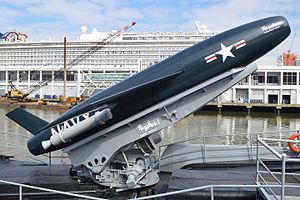This article includes a list of general references, but it lacks sufficient corresponding inline citations. (April 2009) |
| SSM-N-8 Regulus | |
|---|---|
 SSM-N-8 "Regulus I" display at Intrepid Sea, Air & Space Museum | |
| Type | Cruise missile |
| Place of origin | United States |
| Service history | |
| In service | 1955-64 |
| Used by | United States Navy |
| Production history | |
| Manufacturer | Chance Vought |
| Produced | March 1951 |
| Specifications | |
| Mass | 13,685 pounds (6,207 kg) |
| Length | 32 feet 2 inches (9.80 m) |
| Diameter | 4 feet 8.5 inches (1.435 m) |
| Wingspan | 21 feet (6.4 m) extended 9 feet 10.5 inches (3.010 m) folded |
| Warhead | 3,000 pounds (1,400 kg) such as the W5 warhead or the W27 warhead |
| Engine | Allison J33-A-14 turbojet 4,600 lbf (20 kN) 2 × booster rockets 33,000 lbf (150 kN) |
Operational range | 500 nautical miles (926 km) |
| Maximum speed | Subsonic |
Guidance system | radio-command by ground stations, aircraft, or ships along the flight path |
The SSM-N-8A Regulus or the Regulus I was a United States Navy-developed ship-and-submarine-launched, nuclear-capable turbojet-powered second generation cruise missile, deployed from 1955 to 1964. Its development was an outgrowth of U.S. Navy tests conducted with the German V-1 missile at Naval Air Station Point Mugu in California.[1] Its barrel-shaped fuselage resembled that of numerous fighter aircraft designs of the era, but without a cockpit. Test articles of the Regulus were equipped with landing gear and could take off and land like an airplane.[2] When the missiles were deployed they were launched from a rail launcher, and equipped with a pair of Aerojet JATO bottles on the aft end of the fuselage.
- ^ Regulus: America's First Sea-borne Nuclear Deterrent Archived 11 February 2017 at the Wayback Machine Edward C. Whitman. Undersea Warfare vol. 3 no. 3., pp 31.
- ^ Regulus: The First Nuclear Missile Submarines documentary, Spark, 2002